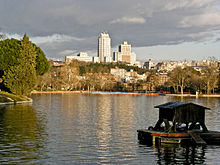-
| This is not a Wikipedia article: It is an individual user's work-in-progress page, and may be incomplete and/or unreliable. For guidance on developing this draft, see Wikipedia:So you made a userspace draft. Find sources: Google (books · news · scholar · free images · WP refs) · FENS · JSTOR · TWL |


The Casa de Campo (for Spanish: Country House) is the largest urban park situated west of central Madrid, (Spain). It is situated in the ward (barrio) of Casa de Campo, in the Moncloa-Aravaca district, bordering with La Latina district to the south, and the municipality of Pozuelo de Alarcón to the west. It has an area of 1722.6 ha, including the lands of the Country Club, which occupies part of its area. This area is twice that of the Bois de Boulogne, in Paris, five times larger than Central Park, New York, and 6.5 times the area of Hyde Park in London.
The Casa de Campo was a historical property of the Spanish Royal Family, and was formerly used as a royal hunting estate. After the proclamation of the Second Republic, it was handed over by the State to the people of Madrid on May 1, 1931. Since that date, it has been open to the public.
The park contains a number of amenities, including an amusement park, a zoo and aquarium, the cable car (which connects the Casa de Campo with the Parque del Oeste, on the other side of the Manzanares river), some of the IFEMA events facilities, Madrid Arena, the Venta del Batán, where bulls are traditionally kept on the days leading up to the bullfight at Las Ventas bullring, and several popular sports facilities.
Overview
editAn amusement park, the Parque de Atracciones de Madrid, and the Madrid Zoo are located inside the park. It is common for families from Madrid to spend days in the park, enjoying the nice weather and looking at the wildlife that may be seen around (mostly squirrels, rabbits and different kinds of birds).
In 1936–39, during the Spanish Civil War, the front lines of the Siege of Madrid ran through the Casa de Campo, where the Republicans had halted a nationalist offensive in November 1936.
The park is also known as an area to find prostitutes, many of whom are unwilling.[1][2][3] The complaints received at the influx of sex workers wearing little clothing have been rejected by the police as the clothing is required for their job.[4][5]
History
editBefore the Habsburgs
editThe area where the Casa de Campo is located is known to have been inhabited by humans since the Palaeolithic age. Neolithic settlements have been found all along the west margin of the Manzanares river.
The Meaques stream is thought to be named after the Roman town of Miaccum, which was established within the park. During the fourth century, the centre of the Iberian peninsula entered a period of decline, aggravated by the arrival of the Arabs in the seventh century, which led to a substantial decrease in the population of the region. This situation began to change when Muhammad I established the fortress Magerit in the ninth century, which would give rise to the city that became known as Madrid.
Towards the end of the fourteenth century, Henry III designated the Monte de El Pardo as the Royal Residency, an occurrence that contributed to the eventual selection of Madrid to be the capital, more than a century later. Following this, a series of noble families strengthened their power and political influence by acquiring neighbouring lands.
Among these was the Vargas family, one of the oldest noble families of medieval Madrid, which purchased agricultural lands adjacent to the Manzanares reaching Carabanchel, including the area that currently comprises the Casa de Campo.
The Habsburgs
editWith the development of Madrid, the Casa de Campo became more important due to the proximity to the city. This importance was especially enhanced by its location in the vicinity of the Royal Alcázar of Madrid, which would be transformed into the current royal palace. In 1519, Francisco de Vargas, a member of the Council of Castile during the reign of the Catholic Monarchs, built a country house on the lands belonging to his family.
Before Philip II permanently established the Court in Madrid in 1561, he bought or expropriated several estates and lands near the Alcázar, with the aim of creating privacy for his future place of residence.
The Bourbons
editPublic spaces
editNature
editGeology
editRelief and hydrography
editFlora
editFauna
editServices and amenities
editHistorical sites
editAccess and transport
editSee also
editReferences
edit- ^ ""Europe's brothel" Spain seeks solutions to prostitution". Khaleej Times. 2006-02-25. Retrieved 2012-08-30.
- ^ "African Women Being Sold Into European ''Sex Slavery''". Digitaljournal.com. 2001-03-14. Retrieved 2012-08-30.
- ^ Tremlett, Giles (2001-02-28). "African women tricked into sex slavery in Spain". The Guardian. London. Retrieved 2012-08-30.
- ^ Boulware, Jack (2000-07-05). "Hookers at the playground". Salon.com. Retrieved 2012-08-30.
- ^ "Madrid Prostitutes Cleared To Dress Down". Pqasb.pqarchiver.com. 2000-06-28. Retrieved 2012-08-30.
External links
edit- Parque de Atracciones de Madrid (in Spanish)
- Zoo de Madrid (in Spanish)
